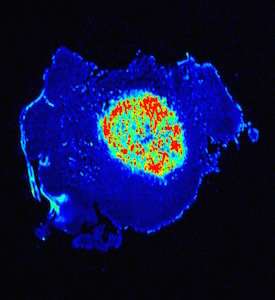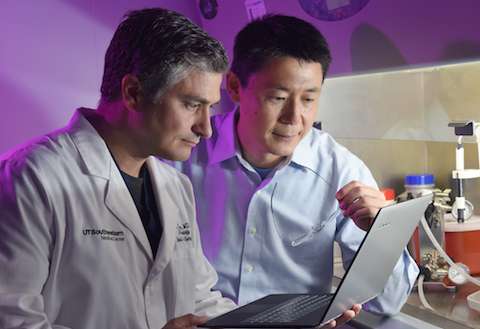The nanosensors lit up on this image show cancer tissue at the microscopic level. The blue background is muscle tissue. Credit: UT Southwestern
UT Southwestern Medical Center researchers have invented a transistor-like threshold sensor that can illuminate cancer tissue, helping surgeons more accurately distinguish cancerous from normal tissue.
In this latest study, researchers were able to demonstrate the ability of the nanosensor to illuminate tumor tissue in multiple mouse models. The study is published in Nature Biomedical Engineering.
"We synthesized an imaging probe that stays dark in normal tissues but switches on like a light bulb when it reaches solid tumors. The purpose is to allow surgeons to see tumors better during surgery," said senior author Dr. Jinming Gao, Professor of Oncology, Pharmacology and Otolaryngology with the Harold C. Simmons Comprehensive Cancer Center.
The nanosensor amplifies pH signals in tumor cells to more accurately distinguish them from normal cells.
"Cancer is a very diverse set of diseases, but it does have some universal features. Tumors do not have the same pH as normal tissue. Tumors are acidic, and they secrete acids into the surrounding tissue. It's a very consistent difference and was discovered in the 1920's," said Dr. Baran Sumer, Associate Professor of Otolaryngology, and co-senior author of the study.
The researchers hope the improved surgical technology can eventually benefit cancer patients in multiple ways.
Dr. Baran Sumer (left) and Dr. Jinming Gao (right) and have invented a transistor-like threshold sensor that can illuminate cancer tissue, helping surgeons more accurately distinguish cancerous from normal tissue in mouse models. Credit: UT Southwestern
"This new digital nanosensor-guided surgery potentially has several advantages for patients, including more accurate removal of tumors, and greater preservation of functional normal tissues," said Dr. Sumer. "These advantages can improve both survival and quality of life."
For example, this technology may help cancer patients who face side effects such as incontinence after rectal cancer surgery.
"The new technology also can potentially assist radiologists by helping them to reduce false rates in imaging, and assist cancer researchers with non-invasive monitoring of drug responses," said Dr. Gao.
According to the National Cancer Institute, there are 15.5 million cancer survivors in the U.S., representing 4.8 percent of the population. The number of cancer survivors is projected to increase by 31 percent, to 20.3 million, by 2026.
More information: Tian Zhao et al. A transistor-like pH nanoprobe for tumour detection and image-guided surgery, Nature Biomedical Engineering (2016). DOI: 10.1038/s41551-016-0006
Provided by UT Southwestern Medical Center






















